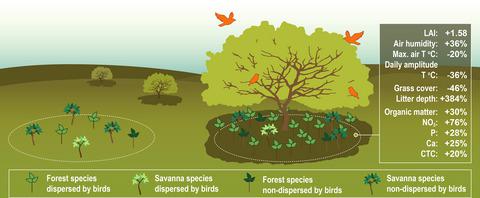当前位置:
X-MOL 学术
›
J. Appl. Ecol.
›
论文详情
Our official English website, www.x-mol.net, welcomes your feedback! (Note: you will need to create a separate account there.)
Facilitation by isolated trees triggers woody encroachment and a biome shift at the savanna–forest transition
Journal of Applied Ecology ( IF 5.7 ) Pub Date : 2021-08-18 , DOI: 10.1111/1365-2664.13994 Rodolfo C. R. Abreu 1, 2 , Giselda Durigan 3, 4 , Antônio C. G. Melo 3 , Natashi A. L. Pilon 4 , William A. Hoffmann 2
中文翻译:

孤立树木的促进作用引发了热带稀树草原 - 森林过渡的木质侵占和生物群落转变
更新日期:2021-08-18
Journal of Applied Ecology ( IF 5.7 ) Pub Date : 2021-08-18 , DOI: 10.1111/1365-2664.13994 Rodolfo C. R. Abreu 1, 2 , Giselda Durigan 3, 4 , Antônio C. G. Melo 3 , Natashi A. L. Pilon 4 , William A. Hoffmann 2
Affiliation

|
- Woody encroachment into grassy biomes is a global phenomenon, often resulting in a nearly complete turnover of species, with savanna specialists being replaced by forest-adapted species. Understanding the mechanisms involved in this change is important for devising strategies for managing savannas.
- We examined how isolated trees favour woody encroachment and species turnover by overcoming dispersal limitation and environmental filtering. In a savanna released from fire in south-eastern Brazil (Cerrado), we sampled woody plants establishing under 40 tree canopies and in paired treeless plots. These trees comprised eight species selected for habitat preference (savanna or forest) and dispersal syndrome (bird dispersed or not). We recorded dimensions of each tree, dispersal syndrome and habitat preference of recruits, and quantified the physical environment within each plot, aiming at a mechanistic understanding of woody encroachment.
- We found clear evidence that isolated trees cause nucleation and drive changes in functional composition of savanna. Effectiveness as nucleator differed among species, but was unrelated to their functional guilds (habitat preference or dispersal syndrome). The density of saplings in nuclei was partially explained by soil moisture (+), daily temperature amplitude (−) and sum of bases (−).
- Our results indicate that isolated trees act first as perches, strongly favouring bird-dispersed species. They then act as nurse trees, considerably changing the environment in favour of forest-adapted recruits. In the long term, as the nuclei expand and merge, savanna specialists tend to disappear and the savanna turns into a low-diversity forest.
- Synthesis and applications. Fire suppression has allowed the nucleation process and consequently the woody encroachment and fast replacement of savanna specialists by forest species in the Cerrado. By elucidating the mechanisms behind woody encroachment, we recommend using prescribed fires to burn forest seedlings and to reduce tree canopy size wherever the management goal is to maintain the typical savanna structure and composition.
中文翻译:

孤立树木的促进作用引发了热带稀树草原 - 森林过渡的木质侵占和生物群落转变
- 木本植物侵入草地生物群落是一种全球现象,通常导致物种几乎完全更替,稀树草原专家被森林适应物种所取代。了解这种变化所涉及的机制对于制定管理稀树草原的策略很重要。
- 我们研究了孤立的树木如何通过克服扩散限制和环境过滤来促进木本侵占和物种周转。在巴西东南部(塞拉多)火灾释放的稀树草原中,我们对在 40 个树冠下和成对的无树地块中建立的木本植物进行了采样。这些树木包括八个根据栖息地偏好(稀树草原或森林)和扩散综合征(鸟类是否扩散)而选择的物种。我们记录了每棵树的尺寸、新兵的扩散综合征和栖息地偏好,并量化了每个地块内的物理环境,旨在对木本侵占进行机械理解。
- 我们发现了明确的证据表明孤立的树木会导致成核并驱动稀树草原功能组成的变化。作为成核剂的有效性因物种而异,但与它们的功能行会(栖息地偏好或扩散综合征)无关。细胞核中树苗的密度部分由土壤水分 (+)、每日温度幅度 (-) 和基数总和 (-) 来解释。
- 我们的结果表明,孤立的树木首先充当栖息地,强烈支持鸟类散布的物种。然后他们充当护士树,大大改变了环境,有利于适应森林的新兵。从长远来看,随着细胞核的扩张和融合,稀树草原专家往往会消失,稀树草原变成低多样性森林。
- 合成与应用。灭火使成核过程成为可能,因此木本侵占和塞拉多森林物种迅速取代稀树草原专家。通过阐明木本侵占背后的机制,我们建议在管理目标是保持典型热带稀树草原结构和组成的任何地方使用规定的火来燃烧森林幼苗并减少树冠大小。



























 京公网安备 11010802027423号
京公网安备 11010802027423号